|
|
Post by Bonobo on Aug 8, 2012 10:04:13 GMT 1
In Palmiry, near Warsaw, there are the graves of more than 2000 Poles, including many prominent representatives of Polish political and cultural circles.
During the summer of 1940, the SS rounded up members of the intelligentsia in the General Government. In this so-called A-B Aktion (Extraordinary Pacification Operation), several thousand university professors, teachers, priests, politicians, sportstmen, and others were shot.
en.wikipedia.org/wiki/Palmiry
Most of the victims were first arrested and tortured in the Pawiak prison in Warsaw, and then transferred to the execution site. Altogether, the remains of at least 2115 men and women were exhumed, but it is probable that not all bodies were found. Among the known victims were:
* Juliusz Dąbrowski, journalist and one of the leaders of Polish Scouting
* Witold Hulewicz, poet and radio journalist
* Stefan Kopeć, biologist and physiologist, professor of the University of Warsaw
* Janusz Kusociński, athlete, winner of 10 000 m at the 1932 Summer Olympics.
* Mieczysław Niedziałkowski, politician of the Polish Socialist Party
* Stanisław Piasecki, journalist, politician and art critic
* Jan Pohoski, politician, former deputy president of Warsaw
* Dawid Przepiórka, chess master
* Maciej Rataj, politician, Marshal of the Sejm
* Kazimierz Zakrzewski, scientist, professor of the University of Warsaw
Mpre photos here: histmag.org/?id=5666 |
|
|
|
Post by propatriapoland on Jan 27, 2019 21:29:49 GMT 1
During World War II, the Radogoszcz prison was a German Order Police and Gestapo prison in Łódź (German: Erweitertes Polizeigefängnis, Radegast), used by the German authorities during the Nazi occupation of Poland in 1939–1945. As Łódź was about to be overrun by the Red Army, the prison staff began to exterminate all the prisoners. After they began shooting the sick in the hospital they experienced resistance, and decided to lock the entire building and set it alight. Of the 1,500 prisoners in the 4 storey part of the building that was burned, only 30 survived, many in a water tank on the top floor. The only person convicted of crimes committed at the prison was the commandant Walther Pelzhausen who was captured in the American Zone.
|
|
|
|
Post by propatriapoland on Jan 28, 2019 13:35:36 GMT 1
During the 2nd World War there was the Gestapo headquarters in Krakow, at 2, Pomorska Street. The cells of the previous Gestapo prison – the testimony of the past of this place – nowadays are the place of national memory and the most important point of the upcoming exhibition. The exhibition People of Kraków in Times of Terror 1939-1945-1956, telling the complex history of our city, prepares the visitors to see the cells, where Polish people, fighting for Polish freedom and independence, were tortured and murdered.
|
|
|
|
Post by Bonobo on Jan 28, 2019 22:38:09 GMT 1
During the 2nd World War there was the Gestapo headquarters in Krakow, at 2, Pomorska Street. The cells of the previous Gestapo prison – the testimony of the past of this place – nowadays are the place of national memory and the most important point of the upcoming exhibition. The exhibition People of Kraków in Times of Terror 1939-1945-1956, telling the complex history of our city, prepares the visitors to see the cells, where Polish people, fighting for Polish freedom and independence, were tortured and murdered. I was to the Museum only once, as a high school student, on a school trip and then never wanted to visit the place again. Too horrible atmosphere. But I visited a similar place in Warsaw, I mean Pawiak, of course. Photo story here: polandsite.proboards.com/thread/4573/pawiak-biggest-german-prison-ww2 |
|
|
|
Post by propatriapoland on Feb 10, 2019 22:03:11 GMT 1
Intelligenzaktion (Intelligentsia action) was a secret mass murder conducted by Nazi Germany against the Polish intelligentsia (teachers, priests, physicians, et al.) early in the Second World War. The operations were conducted to realise the Germanization of the western regions of occupied Poland, before territorial annexation to the German Reich.
|
|
|
|
Post by pjotr on Feb 12, 2019 22:32:04 GMT 1
Excellent video Propatria Poland. The video says the same, but those who want to read to story too. Under here the wikipedia and google image search version of the same story. Intelligenzaktion Mass shootings in Darzlubska Wilderness. Puszcza Darżlubska is located in northernmost part of Poland, is a Polish forests complex on the Baltic Sea, within the geographical region of Pobrzeże Kaszubskie. Puszcza Darżlubska is a place of Polish and Jewish martyrology; the second largest site of mass killings of Polish civilians in Pomerania (after Stutthof) during World War II. The waves of Nazi German executions, known as the Mass murders in Piaśnica, of about 12,000–16,000 hostages (mostly intelligentsia), were committed between the fall of 1939 and spring of 1940 near the town of Wielka Piaśnica.Intelligenzaktion (German pronunciation: [ɪntɛliˈɡɛnt͡s.akˌt͡sjoːn], Intelligentsia action) was a secret mass murder conducted by Nazi Germany against the Polish intelligentsia (teachers, priests, physicians, et al.) early in the Second World War (1939–45). The operations were conducted to realise the Germanization of the western regions of occupied Poland, before territorial annexation to the German Reich. Mass shootings in Darzlubska Wilderness. Puszcza Darżlubska is located in northernmost part of Poland, is a Polish forests complex on the Baltic Sea, within the geographical region of Pobrzeże Kaszubskie. Puszcza Darżlubska is a place of Polish and Jewish martyrology; the second largest site of mass killings of Polish civilians in Pomerania (after Stutthof) during World War II. The waves of Nazi German executions, known as the Mass murders in Piaśnica, of about 12,000–16,000 hostages (mostly intelligentsia), were committed between the fall of 1939 and spring of 1940 near the town of Wielka Piaśnica.Intelligenzaktion (German pronunciation: [ɪntɛliˈɡɛnt͡s.akˌt͡sjoːn], Intelligentsia action) was a secret mass murder conducted by Nazi Germany against the Polish intelligentsia (teachers, priests, physicians, et al.) early in the Second World War (1939–45). The operations were conducted to realise the Germanization of the western regions of occupied Poland, before territorial annexation to the German Reich.
Adolf Hitler ordered the murder of the intelligentsia and the social élites of Poland to prevent them from organising the Poles against their German masters, and thwart the occupation and colonisation of the country; the mass murder was to occur before the annexation of Poland to the Greater Germanic Reich:
Once more, the Führer must point out that the Poles can only have one master, and that is the German; two masters cannot and must not exist side by side; therefore, all representatives of the Polish intelligentsia should be eliminated [umbringen]. This sounds harsh, but such are the laws of life.

Hitler reviewing troops in Warsaw
Nazi racialism considered the Polish élites as being most likely of German blood, because their style of dynamic leadership contrasted positively against the “Slavonic fatalism” of the Russian people; nonetheless, the extermination of such national leaders was necessary, because their patriotism (moral authority) would prevent the full-scale Germanization of the enslaved populace of Poland.

Execution of Polish citizens by German and Austrian Nazi forces
The mass murder operations of Intelligenzaktion killed 100,000 Polish people; by way of forced disappearance, the Nazis imprisoned and killed selected citizens of Polish society, identified before the war as enemies of the Reich; they were buried in mass graves at remote places. To facilitate the depopulation of Poland, the Nazis terrorised the general populace with the public, summary executions of selected intellectuals and community leaders, before effecting the expulsions of the general population from occupied Poland. The executioners of the Einsatzgruppen death squads and the local Volksdeutscher Selbstschutz, the German-minority militia, pretended that their police-work was meant to eliminate politically dangerous people from Polish society.

Execution of Polish citizens by German and Austrian Nazi forces outside Lublin
The Intelligenzaktion was a major step to implementing Sonderaktion Tannenberg (Operation Tannenberg), the installation of Nazi policemen and functionaries — from the SiPo [Sicherheitspolizei] (composed of the Kripo and Gestapo), and the SD [Sicherheitsdienst] — to manage the occupation and facilitate the realisation of Generalplan Ost, the German colonization of Poland. Among the 100,000 people killed in the Intelligenzaktion operations, approximately 61,000 were of the Polish intelligentsia, whom the Nazis identified as political targets in the Special Prosecution Book-Poland, compiled before the war began in September 1939. The Intelligenzaktion occurred soon after the German invasion of Poland (1 September 1939), and lasted from the autumn of 1939 until the spring of 1940; the mass murder of the Polish intellectuals continued with the operations of German AB-Aktion operation in Poland.
In "special operations" (AB-Aktion, #Intelligenzaktion, etc.) Nazi Germany murdered a large part of the Polish elites / intelligentsia:
39 % of doctors
33 % of teachers
30 % of scientists & professors
28 % of priests
26 % of lawyers Members of a German execution squad by murdered Polish civilians who are the victim of the Intelligenzaktion Members of a German execution squad by murdered Polish civilians who are the victim of the Intelligenzaktion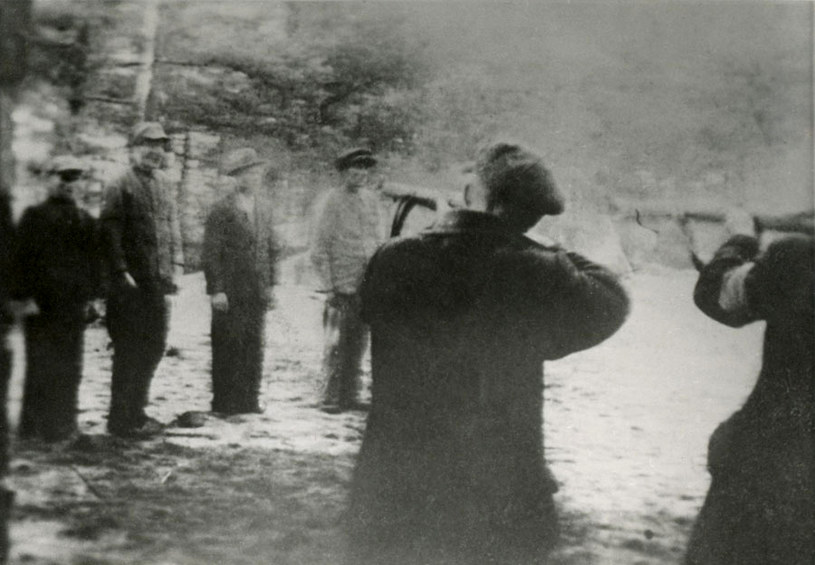 Members of the Polish intelligentsia being shot by the Volksdeutscher Selbstschutz, the Ethnic Self-defence militia of the German minority in Poland Members of the Polish intelligentsia being shot by the Volksdeutscher Selbstschutz, the Ethnic Self-defence militia of the German minority in Poland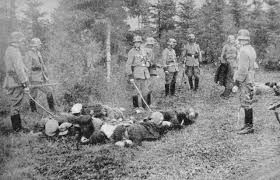 Small execution site in Rudzki Most (24 October- 10 November 1939) Poles killed by local Germans from Selbstschutz, overseen by the SS. Small execution site in Rudzki Most (24 October- 10 November 1939) Poles killed by local Germans from Selbstschutz, overseen by the SS. First, in August 1939 about 2,000 activists of Polish minority organisations in Germany were arrested and murdered. The second part of the action began on September 1, 1939, and ended in October, resulting in at least 20,000 deaths in 760 mass executions by Einsatzgruppen special task units with some help from regular Wehrmacht (armed forces) units. In addition, a special formation was created from the German minority living in Poland called Selbstschutz, whose members had trained in Germany before the war in diversion and guerilla fighting. The formation was responsible for many massacres and due to its bad reputation was dissolved by Nazi authorities after the September Campaign. First, in August 1939 about 2,000 activists of Polish minority organisations in Germany were arrested and murdered. The second part of the action began on September 1, 1939, and ended in October, resulting in at least 20,000 deaths in 760 mass executions by Einsatzgruppen special task units with some help from regular Wehrmacht (armed forces) units. In addition, a special formation was created from the German minority living in Poland called Selbstschutz, whose members had trained in Germany before the war in diversion and guerilla fighting. The formation was responsible for many massacres and due to its bad reputation was dissolved by Nazi authorities after the September Campaign. Poles sentenced to death without trial face the firing squad in Nazi-occupied Poland, 1939 Poles sentenced to death without trial face the firing squad in Nazi-occupied Poland, 1939  10 stycznia 1940 r. niemiecki Selbstschutz dokonał ostatniej masowej egzekucji w lesie Barbarka pod Toruniem. Od października 1939 r. zamordowano tam od 600 do 1200 przedstawicieli polskiej inteligencji z miasta i jego okolic. 10 stycznia 1940 r. niemiecki Selbstschutz dokonał ostatniej masowej egzekucji w lesie Barbarka pod Toruniem. Od października 1939 r. zamordowano tam od 600 do 1200 przedstawicieli polskiej inteligencji z miasta i jego okolic.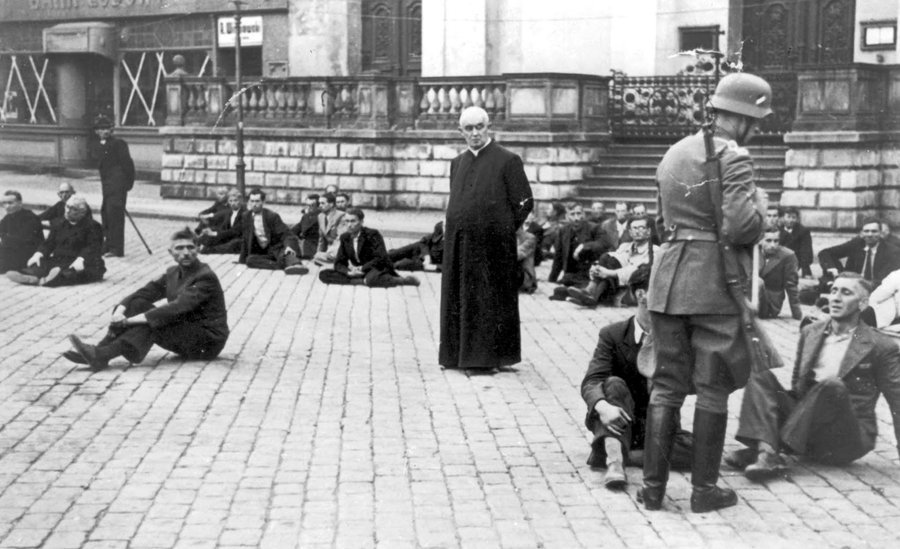 This photo was taken in Old Market Square in Bydgoszcz (Poland) on 9 September 1939. This photo was taken in Old Market Square in Bydgoszcz (Poland) on 9 September 1939. 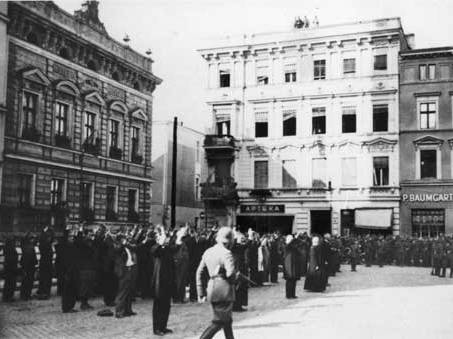 Intelligenzaktion: In occupied Poland, on 9 September 1939, the Nazis publicly executed twenty-five prominent citizens, before the Municipal Museum, in the Market Square of Bydgoszcz. To terrorise the townsfolk, the Nazis displayed the bodies for six hours. Intelligenzaktion: In occupied Poland, on 9 September 1939, the Nazis publicly executed twenty-five prominent citizens, before the Municipal Museum, in the Market Square of Bydgoszcz. To terrorise the townsfolk, the Nazis displayed the bodies for six hours. Public execution of Polish priests and civilians in Bydgoszcz's Old Market Square 9 September 1939. Public execution of Polish priests and civilians in Bydgoszcz's Old Market Square 9 September 1939. Public execution of Polish priests and civilians in Bydgoszcz's Old Market Square 9 September 1939. Public execution of Polish priests and civilians in Bydgoszcz's Old Market Square 9 September 1939. Sonderfahndungsbuch Polen book - lists of 60,000 targets in Intelligenzaktion. Sonderfahndungsbuch Polen book - lists of 60,000 targets in Intelligenzaktion. Sonderfahndungsbuch Polen- Page with names under the letter "G" with abbreviations. EK stands for Einsatzkommando death squad, and EG stands for Einsatzgruppen authorities. Sonderfahndungsbuch Polen- Page with names under the letter "G" with abbreviations. EK stands for Einsatzkommando death squad, and EG stands for Einsatzgruppen authorities. Source:en.wikipedia.org/wiki/Intelligenzaktionpl.wikipedia.org/wiki/Intelligenzaktion Source:en.wikipedia.org/wiki/Intelligenzaktionpl.wikipedia.org/wiki/Intelligenzaktion |
|
|
|
Post by propatriapoland on Mar 28, 2019 19:09:08 GMT 1
Intelligenzaktion was a secret mass murder conducted by Nazi Germany against the Polish intelligentsia (teachers, priests, physicians, et al.) early in the Second World War (1939–45). The operations were conducted to realise the Germanization of the western regions of occupied Poland, before territorial annexation to the German Reich. The mass murder operations of Intelligenzaktion killed 100,000 Polish people.
|
|
|
|
Post by Bonobo on Feb 4, 2020 9:34:10 GMT 1
One of first mass executions by Germans in occupied Poland. en.wikipedia.org/wiki/Wawer_massacre
The Wawer massacre refers to the execution of 107 Polish civilians on the night of 26 to 27 December 1939 by the Nazi German occupiers of Wawer (near Warsaw), Poland. The execution was a response to the deaths of two German NCOs. 120 people were arrested and 114 shot, of whom 7 survived.
It is considered to be one of the first large scale massacres of Polish civilians by Nazi Germany in occupied Poland.
Contents
1 Background
2 Massacre
3 Aftermath
4 See also
5 References
6 Further reading
7 External links
Background
Nazi Germany invaded and occupied Poland in September 1939. From the start, the war against Poland was intended to be the fulfilment of a plan described by Adolf Hitler in his book Mein Kampf. The main gist of the plan was for all of Eastern Europe to become part of a Greater Germany, the German Lebensraum ("living space").
On the evening of 26 December, two known Polish criminals, Marian Prasuła and Stanisław Dąbek, killed two German non-commissioned officers from Baubataillon 538.[1][2] After learning of it, the acting commander of the Ordnungspolizei in Warsaw, colonel Max Daume[3] ordered an immediate reprisal, consisting of a series of arrests of random Polish males, aged 16 to 70, found in the region where the killings occurred (in Wawer and the neighboring Anin villages).[1][4]
Massacre
After a kangaroo court presided over by Major General Friedrich Wilhelm Wenzl, 114 of the 120 people arrested - who had no knowledge of the recent killings, many of whom were roused from their beds - were sentenced to death.[1] They were not given the opportunity to plead their case.[1] Of the 114, one managed to escape, 7 were shot but not killed and managed to escape later, and 107 were shot dead.[1][2][4] The dead included one professional military officer, one journalist, two Polish-American citizens and a 12-year-old boy.[1][5] Some of the executed were not locals, but merely visiting their families for Christmas.[1]
Aftermath
It was one of the earliest massacres (probably the second, after the Bochnia massacre of 52 civilians on December 18) to occur in occupied Poland. It was also one of the first instances of the large scale implementation by Germany of the doctrine of collective responsibility in the General Government in Poland since the end of the invasion in September.[4][6][7]
Kotwica.
Soon after the massacre, a Polish youth resistance organization, "Wawer", was created.[1] It was part of the Szare Szeregi (the underground Polish Scouting Association), and its first act was to create a series of graffiti in Warsaw around the Christmas of 1940, commemorating the massacre.[1][2][6] Members of the AK Wawer "Small Sabotage" unit painted "Pomścimy Wawer" ("We'll avenge Wawer") on Warsaw walls. At first they painted the whole text, then to save time they shortened it to two letters, P and W. Later they invented Kotwica -"Anchor" - the symbol, a combination of these 2 letters, was easy and fast to paint. Next kotwica gained more meanings - Polska Walcząca ("Fighting Poland") . It also stands for Wojsko Polskie ("Polish Army") and Powstanie Warszawskie ("Warsaw Uprising"). Finally "Kotwica" became a patriotic symbol of defiance against the occupiers and was painted on building walls everywhere.
On 3 March 1947, the Polish Supreme National Tribunal for the Trial of War Criminals (Najwyższy Trybunał Narodowy) sentenced Max Daume to death.[1] Wilhelm Wenzel was extradited to Poland by the Soviets in 1950 and executed in November 1951.[1]
There is now a monument in Wawer commemorating the massacre. tvn24.pl/magazyn-tvn24/padl-udawal-martwego-zorientowalem-sie-ze-ktos-idzie-i-dobija-ocalalych,249,4323 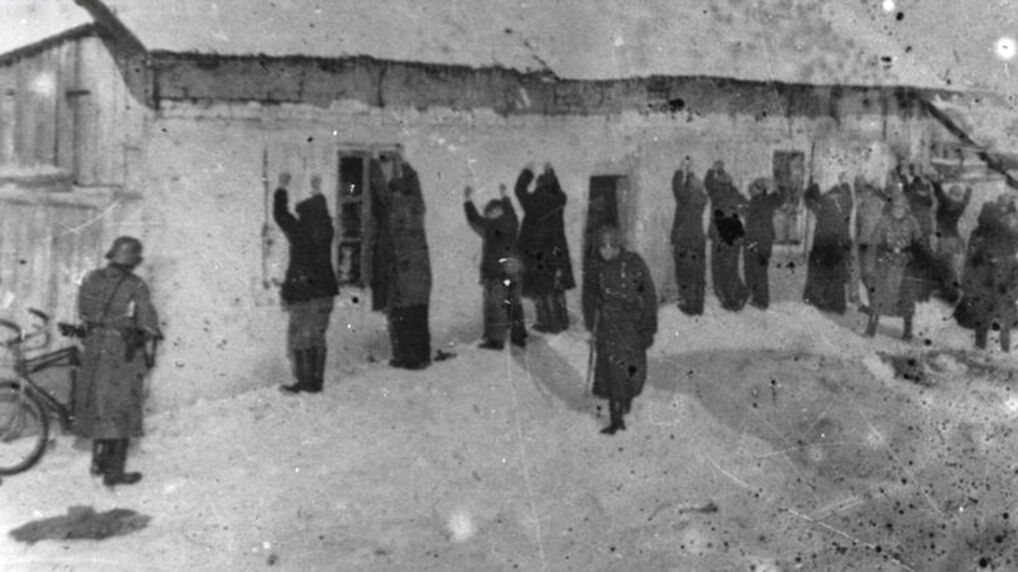   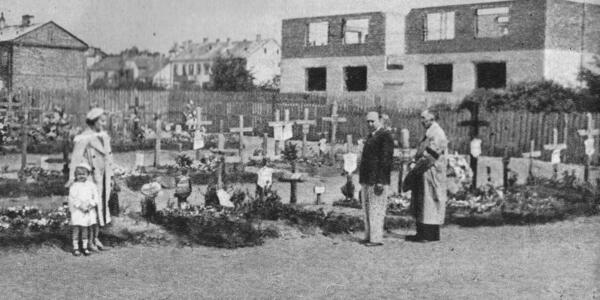  |
|